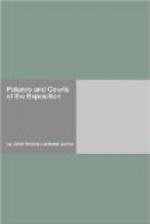“For lasting happiness we turn our eyes to one
alone
And she surrounds you now
Great Nature, refuge of the weary heart, and only
balm to breasts that
have been bruised
She hath cool hands for every fevered brow
And gentlest silence for the troubled soul.”
Near by are August Jaeger’s figures of Abundance, four times repeated on each gateway; also his spandrel figures, still adding harvest thoughts.
Walk along the colonnade to the right —
As you pass the fountains, you will notice how the water slips its silvery pink reflection from the wall down the terraces into the pool below, producing almost a sunrise or a sunset effect.
The long hanging vine on the wall above is muhlenbeckia, the so-called maidenhair vine.
The shorter vine is lotus bertolletti, showing later its red claw-like flowers.
Court of Palms
As a balance to the Court of Flowers at the east end of the block of palaces is the Court of Palms at the west end.
The general effect in color of decoration is pink and blue.
The columns are coupled Ionic of smoked ivory, producing a most lovely effect against the pastel pink walls back of them.
The caryatids lining off the pink and blue marble panels show a soft flush of pink. (These are by A. Stirling Calder and John Bateman.)
The festoons of fruits at the side of the panels are accented in deeper blues and soft reds.
Notice the delicate figures on either side the cartouche over the portals. The pinks and blues are so delightfully combined.
Between the columns, against the wall, are balled acacias.
The Pool in the center of the Court might be called The Pool of Reflections.
In front of this Court is “The End of the Trail,” by James Earle Fraser.
Before you is the end of the Indian race. The poor Indian, following his long trail, has at last come to the end. The worn horse and its rider tell a long, pathetic story.
By the entrances are great vases on which in low relief are Bacchanalian scenes. Satyrs form part of the handles.
-
Over the doorways are beautifully colored murals.
On the west —
Fruits and Flowers, by Childe Hassam, a fine area of superb color.
On the east —
The Pursuit of Pleasure, by Chas. Holloway, gracefully carrying out the idea of this court.
On the north —
“Victorious Spirit,” by Arthur F. Matthews.
This wonderful golden note represents the Victorious Spirit, the Angel of Light, with widespread wings of protection. She is the means by her gentle influence of keeping materialism (represented by the horse driven by brute force) from riding over the higher expressions of life.
Muhlenbeckia borders the pool, producing a most fernlike effect.




